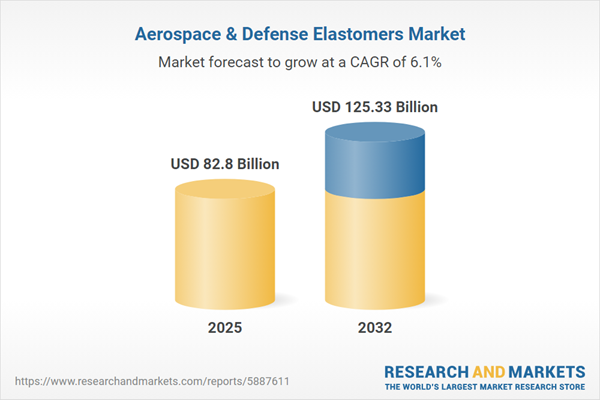Speak directly to the analyst to clarify any post sales queries you may have.
The aerospace and defense elastomers market is evolving as organizations place a premium on material reliability and proactive supplier collaboration to safeguard critical operations. As procurement leaders refine their strategies, compliant and high-performance elastomers enable mission continuity and operational assurance.
Market Snapshot: Aerospace & Defense Elastomers Market
The aerospace and defense elastomers market is experiencing robust growth, reflecting increasing requirements for advanced materials that sustain optimal performance in severe environments. This momentum is propelled by ongoing progress in elastomer chemistry and precision engineering, enabling the integration of high-specification elastomer components into sophisticated aircraft and military systems. Organizations are turning to digital procurement platforms and advanced analytics to enhance regulatory compliance processes, supplier evaluation, and project timeliness. The market’s geographical expansion sees investment across both mature and emerging regions, backed by infrastructure improvements and the need for modernization in fleet operations. Ultimately, elastomer solutions have become essential in systems with rigorous safety and reliability demands, solidifying their role within evolving procurement strategies.
Aerospace & Defense Elastomers Market: Scope & Segmentation
- Elastomer Types: Ethylene propylene diene monomer, fluoroelastomer, nitrile, and silicone are specified for their resistance and adaptability, providing operational stability in demanding aerospace and defense contexts.
- Applications: Seals, gaskets, vibration dampers, and functional parts are essential for hydraulic, fuel, and pneumatic systems, enabling adherence to stringent sector safety protocols.
- Product Forms: Molding compounds, O-rings, U and V profiles, sheets, and engineered films cater to standard assemblies and applications where compliance is mission-critical.
- Distribution Channels: Distributor networks and direct manufacturer sales reach original equipment manufacturers and aftermarket buyer groups, supporting efficient integration and ongoing maintenance demands.
- Regions Covered: Americas, Europe, Asia-Pacific, and Middle East & Africa each face distinct procurement priorities rooted in regional regulation and local investment dynamics.
- Key Markets: United States, Canada, Mexico, Brazil, Germany, France, United Kingdom, China, India, Japan, and Australia serve as primary markets, driven by both modernization needs and evolving readiness requirements.
- Major Companies: BASF SE, Dow Inc., Covestro AG, DuPont de Nemours, The Chemours Company, Evonik, LANXESS, Solvay, Arkema, and Daikin Industries contribute technical innovation and a global service footprint across the segment.
Key Takeaways
- Strategic procurement now emphasizes agile material selection and deeper alignment with evolving compliance standards, ensuring the responsiveness of future aerospace and defense projects.
- Strengthening supply chains relies on in-depth supplier evaluation and systematic recordkeeping, which enhance audit readiness and sustain platform dependability.
- Adoption of advanced analytics for supply chain management empowers maintenance teams to forecast needs and prioritize resources, driving operational continuity.
- Regional procurement approaches are influenced by specific priorities: North America values close supplier relationships, Asia-Pacific emphasizes manufacturing innovation, and Europe and Middle East adapt proactively to regulatory developments.
- Optimizing distribution channel selection directly impacts warranty coverage, dependability, and efficiency of systems deployment in aerospace and defense initiatives.
Tariff Impact
Recent shifts in U.S. tariff policy have prompted diversification in sourcing and greater scrutiny in supplier qualification. Enhanced cross-functional collaboration is now instrumental in addressing compliance risk and maintaining operational continuity in the face of evolving global trade conditions.
Methodology & Data Sources
This market analysis is based on direct interviews with procurement and material science experts, complemented by laboratory testing and digital simulation. All findings are validated through technical documentation, ensuring data integrity and actionable market insights.
Why This Report Matters
- Enables benchmarking of supplier evaluation processes and supports streamlined compliance with aerospace and defense material standards under strict regulatory regimes.
- Provides actionable guidance for designing resilient sourcing strategies, elevating cost control and adaptability during supply volatility or logistical disruptions.
- Equips technical and procurement leaders to refine material specifications, improve inventory processes, and cultivate robust supplier partnerships that drive operational reliability.
Conclusion
Success in the aerospace and defense elastomers market requires proactive sourcing and sustained supplier engagement. As technical requirements evolve, aligning procurement with ongoing innovation remains fundamental to supporting operational integrity and forward growth.
Additional Product Information:
- Purchase of this report includes 1 year online access with quarterly updates.
- This report can be updated on request. Please contact our Customer Experience team using the Ask a Question widget on our website.
Table of Contents
3. Executive Summary
4. Market Overview
7. Cumulative Impact of Artificial Intelligence 2025
Companies Mentioned
The companies profiled in this Aerospace & Defense Elastomers market report include:- BASF SE
- Dow Inc.
- Covestro AG
- DuPont de Nemours, Inc.
- The Chemours Company
- Evonik Industries AG
- LANXESS AG
- Solvay S.A.
- Arkema S.A.
- Daikin Industries, Ltd.
Table Information
| Report Attribute | Details |
|---|---|
| No. of Pages | 193 |
| Published | November 2025 |
| Forecast Period | 2025 - 2032 |
| Estimated Market Value ( USD | $ 82.8 Billion |
| Forecasted Market Value ( USD | $ 125.33 Billion |
| Compound Annual Growth Rate | 6.1% |
| Regions Covered | Global |
| No. of Companies Mentioned | 11 |









